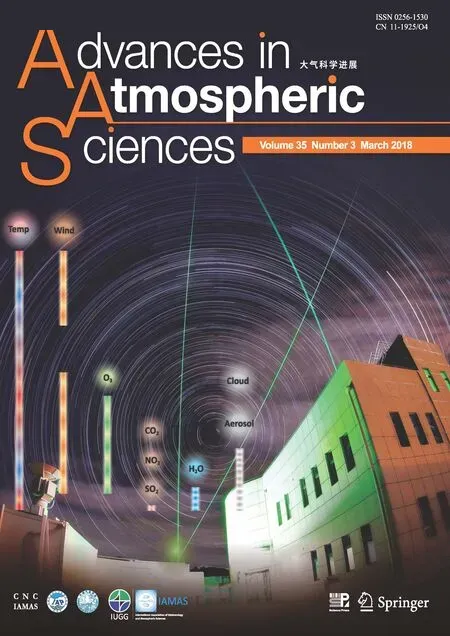Anomalous Western Pacific Subtropical High during El Ni˜no Developing Summer in Comparison with Decaying Summer
2018-01-29FengXUEXiaoDONGandFangxingFAN
Feng XUE,Xiao DONG,and Fangxing FAN
International Center for Climate and Environment Sciences,Institute of Atmospheric Physics,Chinese Academy of Sciences,Beijing 100029,China
1.Introduction
As a major circulation system of the East Asian summer monsoon(EASM)system,the western Pacific subtropical high(WPSH)exhibits a remarkable intraseasonal variation and plays an important role in the EASM rainfall distribution.In particular,the WPSH jumps northwards in mid-June and late July,signaling the start and termination of the meiyu(baiu)period in the Yangtze River basin and Japan.Ueda et al.(1995)found that,associated with the tropical westerly extension to the east of 150◦E in late July,the western Pacific warm pool convection tends to march northwards,resulting in the termination of baiu in Japan.Thefirst jump of the WPSH is mainly caused by the enhancement of the convective activity in the South China Sea,whereas the combined effects of the convective activity over the western Pacific warm pool and the circulation systems in high latitudes lead to the second jump(Su and Xue,2010).It is also noted thattheWPSHtendstoextendwestwardsorretreateastwards associated with the northward jumps.After the second jump in particular,the WPSH retreats to the south of Japan with sharply reduced intensity.The East Asian monsoon region enters into the late summer period characterized by a high temperature and humidity(Xue et al.,2015).
Besidestheintraseasonalvariation,theWPSHexhibitsan interannual variation,which is largely regulated by El Ni˜no–Southern Oscillation(ENSO).It was recognized by Fu and Teng(1988)that the WPSH tends to retreat eastwards with weakened intensity in El Ni˜no developing summer,while an opposite anomaly is found in the decaying summer.Different from the Indian summer monsoon,however,the WPSH shows a more significant anomaly in the decaying summer compared with the developing summer.It was later found thatthewarmpoolconvectionprovidesacruciallinkbetween El Ni˜no and the EASM(Huang and Wu,1989).Lu(2001)further demonstrated that the enhanced warm pool convection can induce a low-level cyclonic anomaly in the subtropical western Pacific,leading to the eastward movement of the WPSH,and vice versa.Recent studies have shown that the Indian Ocean plays an important role in the ENSO and EASM variabilities(Wu and Kirtman,2004).In particular, the EASM anomaly in the decaying summer is associated with a basin-wide warming over the tropical Indian Ocean following an El Ni˜no event.The warming acts like a capacitor sustaining atmospheric anomalies over the Indo-western Pacific Ocean,prolonging the influence of El Ni˜no after its decay.By stimulating a baroclinic Kelvin wave into the western Pacific,the Indian Ocean warming induces suppressed convection and the anomalous anticyclonic circulation over the subtropical western Pacific,resulting in summer rainfall anomalies in East Asia(Yang et al.,2007;Xie et al.,2009).
It is worthwhile to note that the influence of El Ni˜no on the WPSH is related to the climate state in East Asia.In particular,the influences are remarkably different between the early and late summer.For instance,Kawatani et al.(2008)compared the WPSH in summer months and found that the interannual and submonthly variability are smallest in June and largest in August.Xue and Liu(2008)showed that the influence of El Ni˜no on the WPSH changes with the seasonal march in summer,with the weakest influence in June and the strongest influence in August.Xiang et al.(2013)demonstrated that enhanced convection associated with a strong monsoon trough over the western Pacific in the late summer makes the atmospheric response much more sensitive to the external forcing than the early summer,inducing anomalous intensification of the WPSH in August.These studies suggested that the interannual variation of the WPSH is closely related to the seasonal march in the East Asian monsoon region.
Compared with the extensively explored WPSH anomaly in the decaying summer,the anomalous behavior of the WPSH in El Ni˜no developing summers is poorly understood.In particular,the physical mechanism underlying the anomalous WPSH remains unclear.In this study,the WPSH anomaly in the developing summer is systematically examined and compared with its counterpart in the decaying summer.We particularly focus on understanding the physical processes that induce the anomalous WPSH.Section 2 describes the datasets and methods used in the present study.The WPSH anomalies in the developing and decaying summer are compared in section 3.Section 4 focuses on the physical mechanism for the anomalous WPSH in the developing summer.A summary is given in the last section.
2.Data and methods
The present study uses atmospheric circulation data obtained from NCEP-2(Kanamitsu et al.,2002).Outgoing longwave radiation(OLR),derived from satellite observations of the National Oceanic and Atmospheric Administration(NOAA)(Liebmann and Smith,1996),is used to represent the convection intensity in the tropics.The horizontal resolution for both atmospheric circulation and OLR data is 2.5◦×2.5◦(latitude× longitude).Sea surface temperature(SST)data are also taken from NOAA on a 2◦×2◦grid(Smith et al.,2008).All datasets are taken as the 35-year period from 1979 to 2013 to be consistent with the timespan available for the OLR data.
The Ni˜no3.4 index,defined as the regionally averaged SST anomaly over the region(5◦S-5◦N,170◦-120◦W),is derived from the Climate Prediction Center of NOAA(http://www.cpc.ncep.noaa.gov/data/indices/).The conventional criterion for selecting El Ni˜no events is that the Ni˜no3.4 index exceeds 0.5◦C for more than six months(Trenberth,1997).In this study,we consider only major El Ni˜no events,for which the maximum Ni˜no3.4 index exceeds 1.0◦C.As shown in Fig.1,there are eight major El Ni˜no events during 1979–2013:1982–83,1986–87,1991–92,1994–95,1997–98,2002–03,2006-07 and 2009–10.It should be noted that the 1986–87 event persisted until January 1988,but it tended to decay in 1987,so this event is also included in the composite results.Figure 1b shows the composite Ni˜no3.4 index based on the above eight El Ni˜no events.Typically,an El Ni˜no event experiences two years from the developing to decaying stages.It emerges in spring of thefirst year,and develops to an El Ni˜no event with the Ni˜no3.4 index exceeding 0.5◦C in summer.After reaching its maximum in December,it begins to decay in spring of the second year and changes into a La Ni˜na event in summer.
3.Comparison of the WPSH between the developing and decaying summer
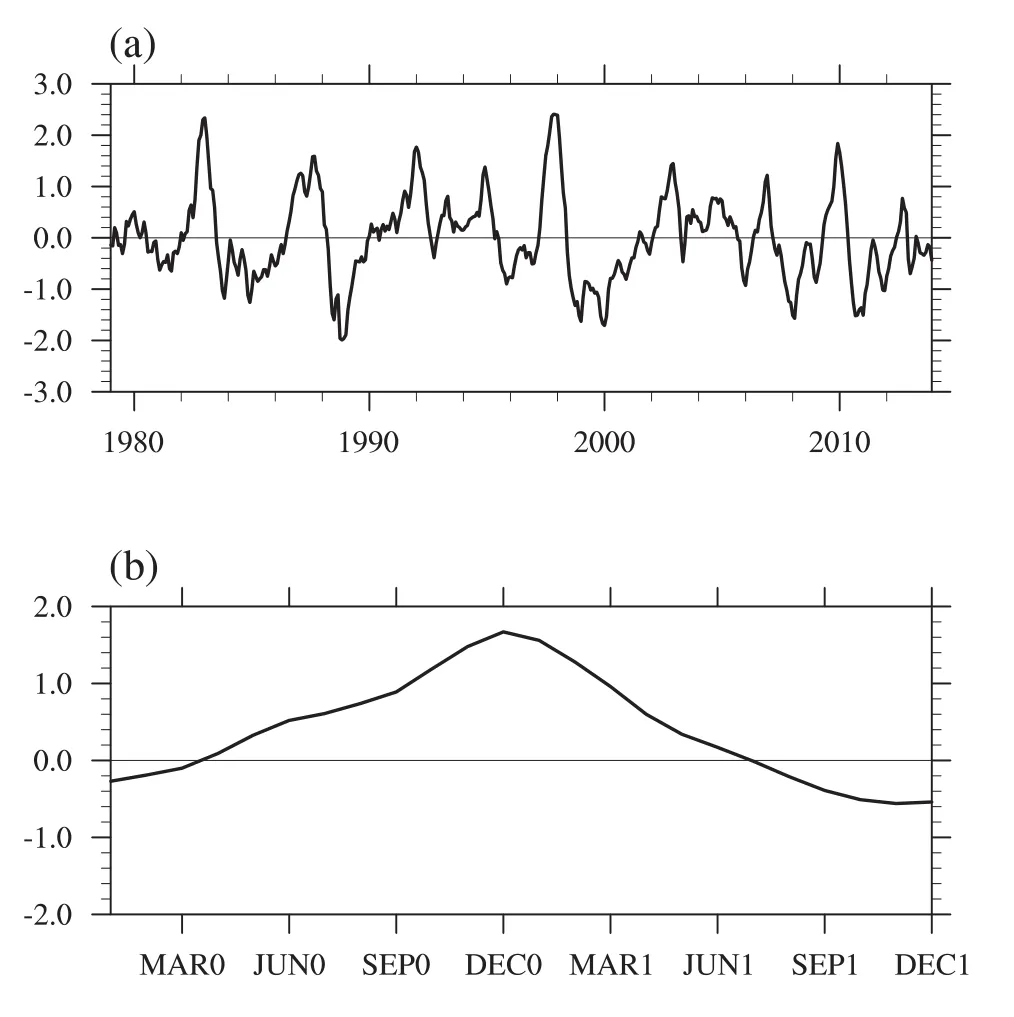
Fig.1.(a)Ni˜no3.4 index from 1979 to 2013;(b)Ni˜no3.4 index for the composite El Ni˜no events(units:◦C).The subscript 0 and 1 indicates the developing and decaying year,respectively.
Figure 2 shows that there are significant differences in the SST anomaly between the developing and decaying summer.In the developing summer(Fig.2a),a typical horseshoe pattern appears in the Pacific with the development of El Ni˜no.The SST in the central and eastern Pacific enhances remarkably,withthemaximumanomalyover0.6◦C.Bycontrast,the SST anomaly in the Pacific weakens sharply in the decaying summer(Fig.2b).Instead,a significant warming is found in theIndo-westernPacific,andtheSSTanomalyexceeds0.4◦C in the South China Sea.Corresponding to the SST anomaly in Fig.2,the tropical convection exhibits a clear anomaly.Convection tends to enhance over the regions with positive SST anomalies(Fig.3).In the developing summer(Fig.3a),negative OLR anomalies(enhanced convection)are located over the central Pacific,especially in the Northern Hemisphere,whereas positive anomalies(suppressed convection)are found near Indonesia.By comparison,in the decaying summer,there are negative anomalies in the tropical Indian Ocean and positive anomalies to the east of Philippines(Fig.3b).
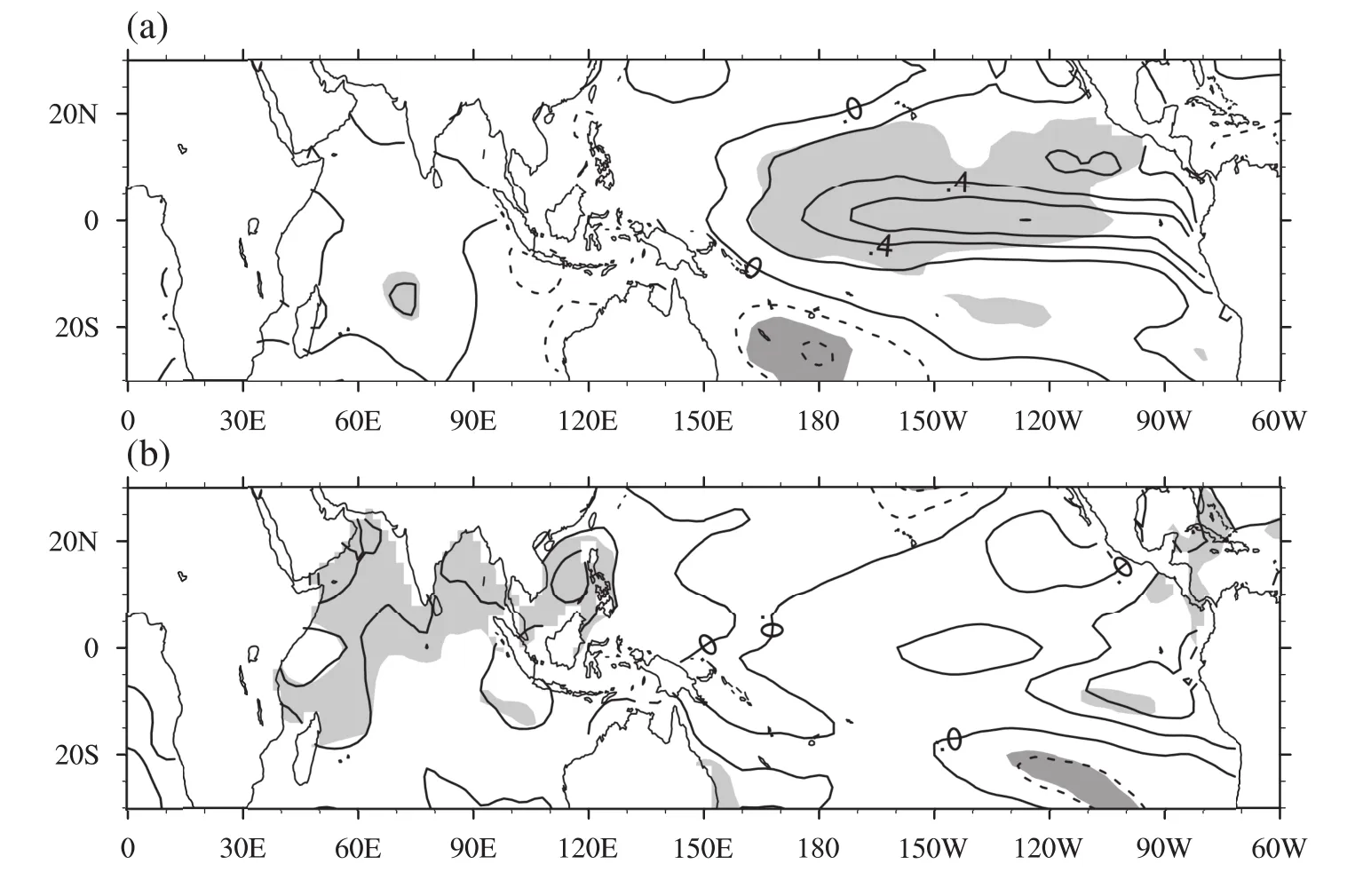
Fig.2.SST anomaly in(a)developing summer and(b)decaying summer(units:◦C).Positive and negative regions above the 95%confidence level are lightly and heavily shaded,respectively.
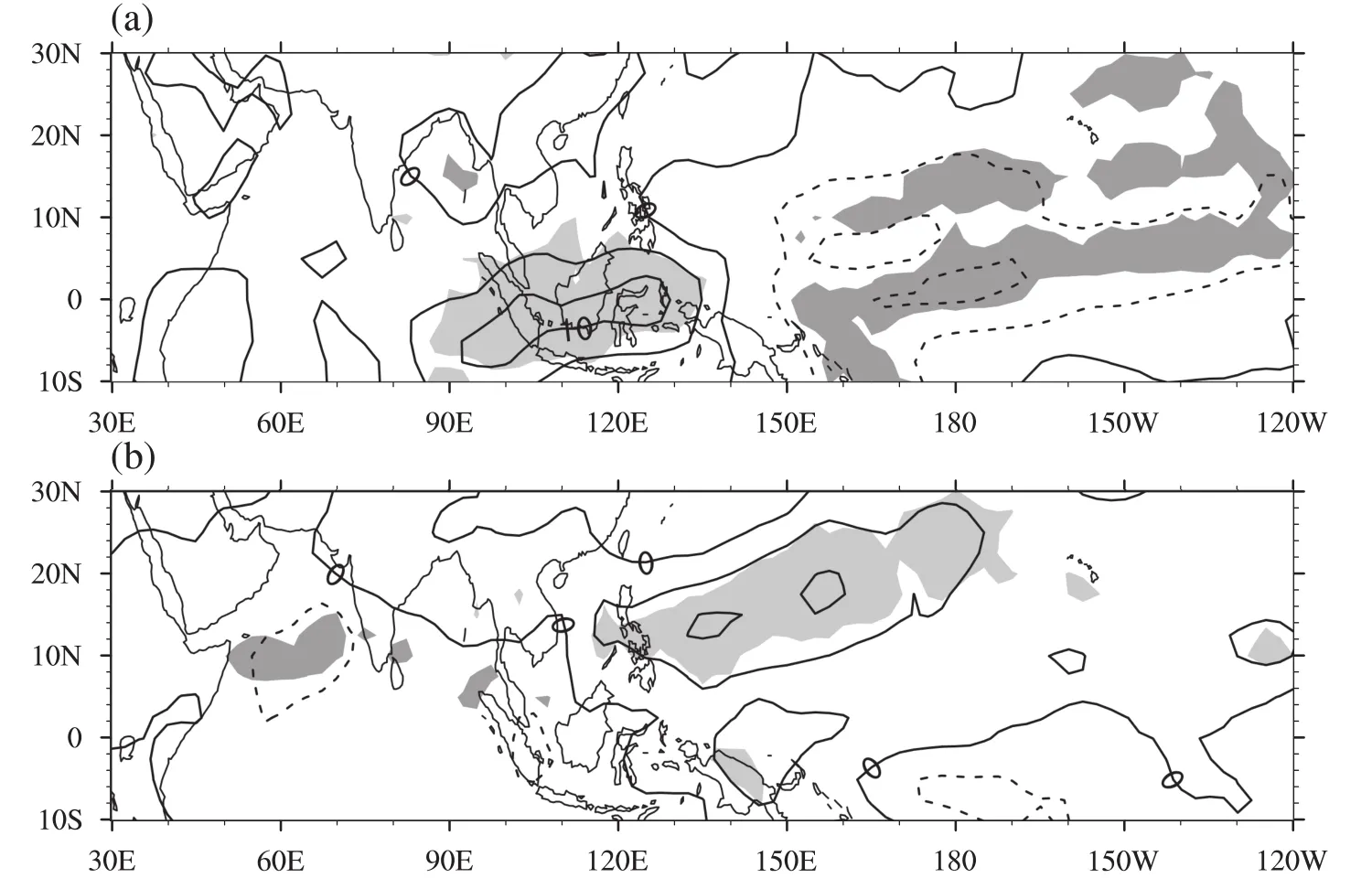
Fig.3.OLR anomaly in(a)developing summer and(b)decaying summer(units:W m−2).Positive and negative regions above the 95%confidence level are lightly and heavily shaded,respectively.
In response to the forcing from the tropical convection,500 hPa geopotential height over East Asia and the western Pacific tends to change accordingly,thereby affecting the WPSH anomaly.As noted in some previous studies(e.g.,Xue and Liu,2008),the influence of El Ni˜no forcing on the WPSH exhibits a clear intraseasonal variation with the seasonal march of the EASM.In particular,the spatial patterns of 500 hPa geopotential height anomalies are significantly different between the early(June to July)and late(August)summer(Fig.4).In June and July of the developing year(Figs.4a and b),geopotential height over East Asia tends to be reduced.A major anomaly center in June is located in Northeast Asia and another center in July is found in southern China.However,the anomalies in most regions are too weak to pass the confidence test.Correspondingly,the WPSH tends to retreat eastwards slightly(Figs.5a and b).Compared with June and July,geopotential height over the western Pacific is reduced significantly in August,especially to the east of the Philippines(Fig.4c).The most significant negative anomalies of geopotential height are just located to the southwest of the WPSH,represented by the 5880 gpm contour,indicating a remarkable retreat of the WPSH in August of the developing year(Fig.5c).Detailed physical explanations for the aforementioned phenomena are provided in the next section.
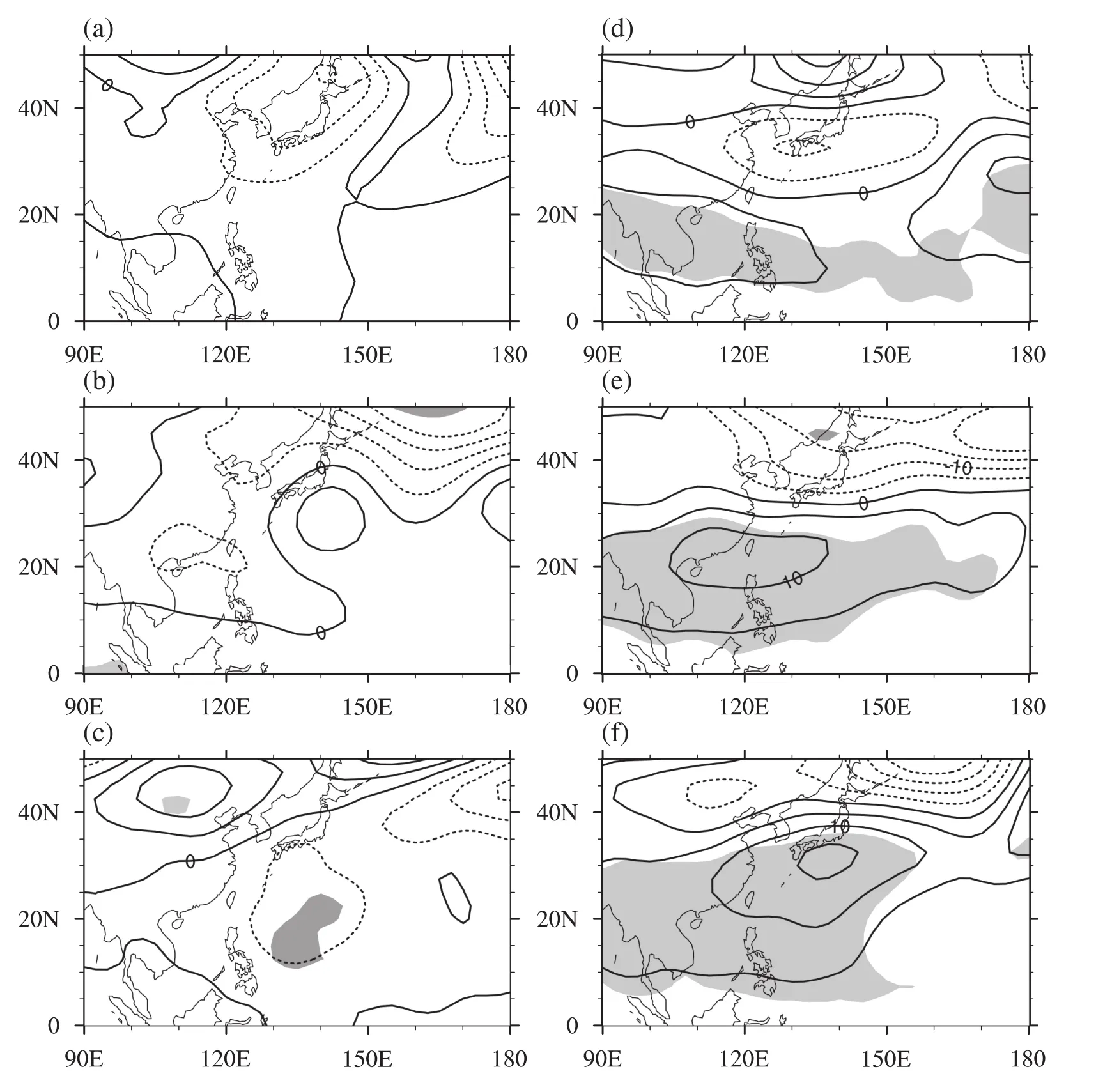
Fig.4.Monthly mean 500 hPa geopotential height anomaly(units:gpm):(a)June in the developing year;(b)July in the developing year;(c)August in the developing year;(d)June in the decaying year;(e)July in the decaying year;(f)August in the decaying year.Positive and negative regions above the 95%confidence level are lightly and heavily shaded,respectively.
To a large degree,the geopotential height anomaly over East Asia and the western Pacific in the decaying summer differs from that in the developing summer mentioned above,but it is also characterized by considerable intraseasonal variation.In June(Fig.4d),geopotential height enhances significantly from Southeast Asia to the east of Philippines but reduces insignificantly near Japan.A typical Pacific–Japan(or East Asia–Pacific)pattern is evident between the lower and higher latitude(Nitta,1987;Huang and Wu,1989).This pattern tends to enhance and expand northwards with the seasonal march of the EASM.In July(Fig.4e),the positive anomalies extend to 30◦N,with a center over 10 gpm near southern China.By August(Fig.4f),the positive anoma-lies continue to extend to 40◦N with a center over 15 gpm to the south of Japan.Associated with the above anomaly,the WPSH tends to extend westwards with stronger intensity,reaching its maximum anomaly in August(Fig.5).These results agree well with a previous study reporting that the influence of El Ni˜no on the WPSH is strongest in the late summer(Xue and Liu,2008).The study by Xie et al.(2009)indicated that the enhanced local convection due to a warmer SST over the Indian Ocean in the decaying summer may suppress the western Pacific warm pool convection by exciting a Kelvin wave.Consequently,suppressed warm pool convection leads to an anticyclonic anomaly and enhanced geopotential height anomaly in the subtropical western Pacific.Our results further indicate that the influence of El Ni˜no during the decaying summer tends to enhance and extend northwards from June to August.Moreover,the anomaly in the decaying summer from June to August is relatively consistent,as compared with the developing summer.Hence,the seasonal mean WPSH anomaly in the decaying summer is much more significant(Fu and Teng,1988).

Fig.5.Monthly mean 500 hPa western Pacific subtropical high represented by the 5880 gpm contour(units:gpm)in(a)June,(b)July and(c)August,in which the solid,long-dashed and short-dashed contours represent the climatology,developing year and decaying year,respectively.
4.Mechanism for the WPSH anomaly in the developing summer
The WPSH in the developing summer shows a larger anomaly in August than that in June and July,implying that the underlying mechanisms for the WPSH anomaly during these two periods are possibly different.Figure 6 illustrates the 850 hPa wind anomaly in June and July of the developing year.A northerly anomaly appears to the north of the WPSH,but it is very weak and below the confidence level.In agreement with a case study by Xue and Fan(2016),the 500 hPa geopotential height in East Asia is reduced through a cold advection anomaly(Figs.4a and b).As a result,the intensity of the WPSH tends to weaken marginally during June and July(Figs.5a and b).It is also worth noting that a significant westerly anomaly in the tropics is related to the development of El Ni˜no(Xue and He,2007).
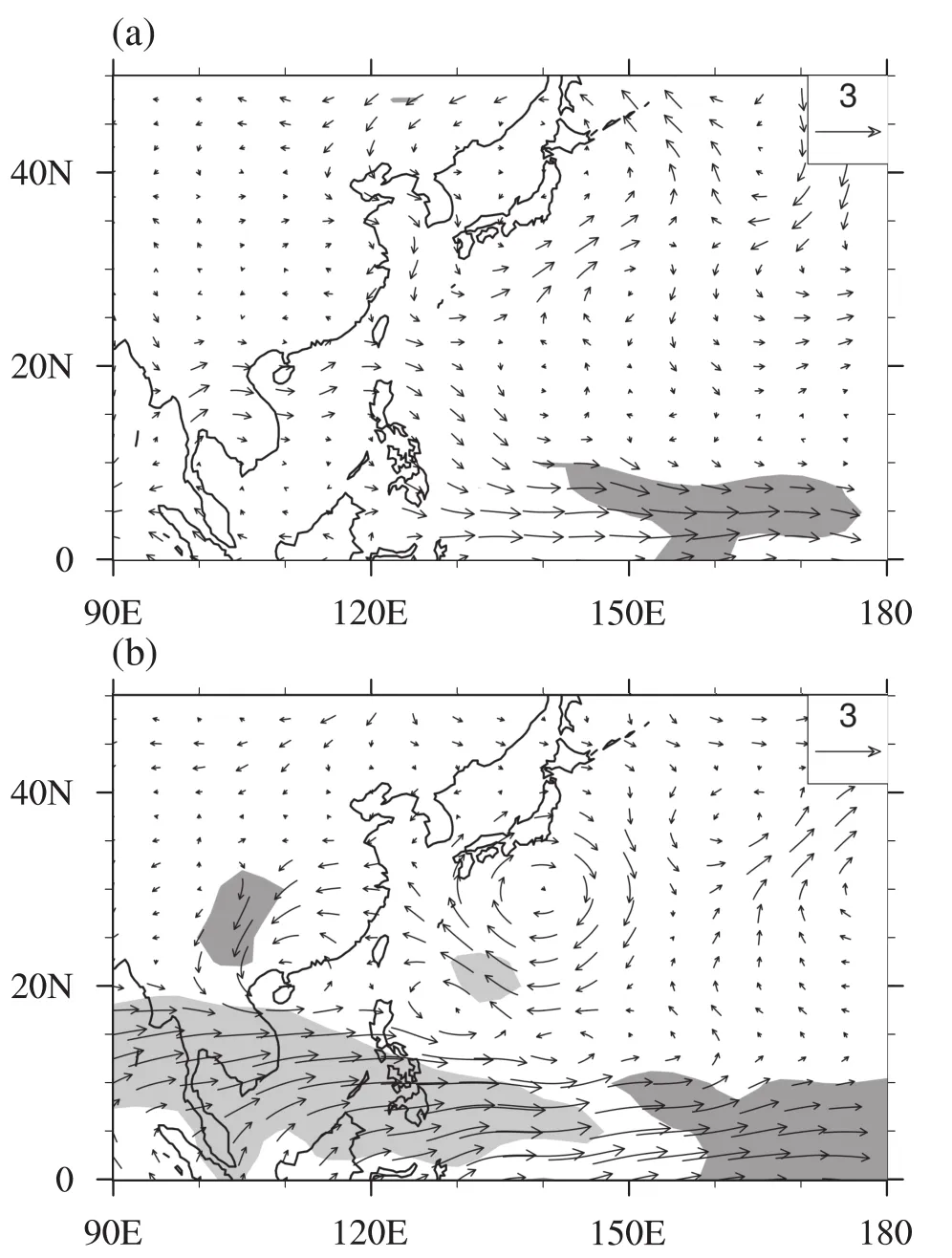
Fig.6.The850 hPawind anomaly in the developingyear(units:ms−1)(a)Juneand(b)July.Positiveandnegativeregionsabove the 95%confidence level are lightly and heavily shaded,respectively.
With the seasonal march from July to August,convective activity and atmospheric circulation over East Asia and the western Pacific experience notable variations.As shown in Fig.7a,a negative OLR difference to the east of the Philippines indicates that convection is enhanced significantly from July to August.By contrast,convection from the Yangtze River basin to Japan is largely suppressed,signifying a shift from the early to late summer in East Asia(Ueda et al.,1995;Su and Xue,2010).A significant cyclonic difference is also evident in East Asia and the western Pacific,with a center to the east of Taiwan(Fig.7b).Besides,the easterly from the Yangtze River basin to Japan and the westerly from the South China Sea to the date line are enhanced from July to August.These changes in atmospheric conditions–especially the enhanced convection to the east of Philippines–contribute to the increased sensitivity of the atmospheric response to El Ni˜no forcing in late summer.Xiang et al.(2013)also noted that the seasonal march of the mean state in the western Pacific plays a dominant role in the anomalous intensification of the WPSH in August.
The OLR anomaly in August of the developing year shows that convection in the tropical central Pacific is enhanced obviously,with two centers in both hemispheres(Fig.8a).By contrast,convection to the west of 140◦E is suppressed,especially over Indonesia.Corresponding to the two positive convective anomaly centers,anomalous cyclonic circulations are induced to the east of the Philippines and Australia,respectively(Fig.8b).This feature is analogous to a Gill-type response to the El Ni˜no forcing(Gill,1980),which can be reproduced well by atmospheric model simulations(Lau and Nath,2000).In the meantime,the tropical westerly anomaly in the western Pacific continues to intensify,as compared with July(Figs.6b and 8b).
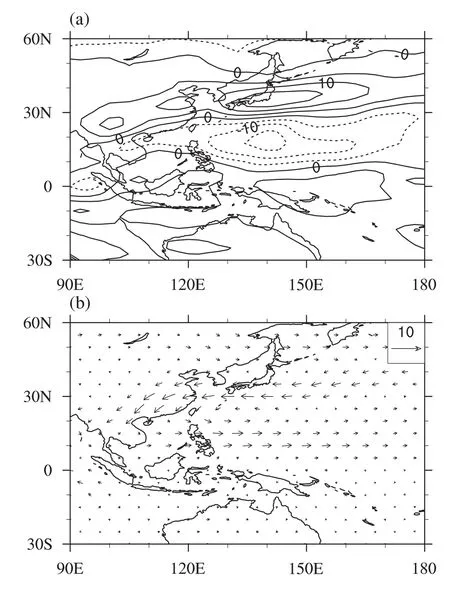
Fig.7.Monthly mean difference between August and July(a)OLR(units:W m−2)and(b)850 hPa wind anomaly(units:m s−1).
The role of the seasonal march of atmospheric circulation over the western Pacific in enhancing the El Ni˜no forcing can further be demonstrated by comparing the wind anomaly between July and August of the developing year.In July(Fig.6b),there is a clear anticyclonic anomaly to the south of Japan and a weak cyclonic anomaly from southern China to the east of east of Philippines.By August(Fig.8b),the western Pacific is dominated by a large-scale cyclonic anomaly induced by El Ni˜no forcing.As the change in the tropical Pacific SST from July to August is quite small(Fig.1b),we may reasonably infer that it is the seasonal march in the western Pacific–especially the enhancement of convection(Fig.7a)–that intensifies the influence of El Ni˜no and contributes to a larger interannual variation of the WPSH in the late summer(Fig.5).
Comparing the low-level circulation patterns between Figs.7b and 8b,we find that the climatological difference pattern between August and July is in many aspects strikingly similar to the anomaly pattern in August of the developing year.Of particular interest is the cyclonic difference between August and July(Fig.7b)and the cyclonic anomaly in August of the developing year(Fig.8b)over the western Pacific,except that the former is located further northwest than the latter.Apparently,the anomalous pattern in August caused by El Ni˜no forcing in the western Pacific coincides to some extent with the climatological difference between August and July.On the one hand,the development of an El Ni˜noeventisaccompaniedbytheaccelerationoftheseasonal march from July to August,which can be manifested by the enhanced warm pool convection(Fig.7a),the cyclonic difference in the western Pacific(Fig.7b),and a more eastward retreat of the WPSH in August of the developing year(Fig.5c).On the other hand,as a prerequisite for the El Ni˜no development,the westerly intensification in the tropical western Pacific from July to August(Fig.7b)is also favorable for the El Ni˜no development(Rasmusson and Carpenter,1982;Xue and He,2007).Therefore,the eastward retreat and weakening of the WPSH in the developing summer is concomitant with the El Ni˜no development,especially in August.
It should be clarified that the coincidence between the seasonal march from July to August and El Ni˜no forcing in August is a unique feature in the western Pacific,which is closely related to the western Pacific summer monsoon in August characterized by enhanced convection to the east of Philippines(Fig.7a).Although a clear cyclonic anomaly also appears to the east of Australia in August(Fig.8b),the seasonal march from July to August in this region is not signifi-cant(Fig.7b).
The WPSH anomaly for the selected eight El Ni˜no years is further compared with the composite result to examine the stability.Consistent with the composite result,the eastward retreats of the WPSH are observed in most individual El Ni˜no developing summers,except for the case of 1991.In June and July of 1991,the WPSH tends to extend westwards due to the unusual circulation in high latitudes(not shown).It can be concluded that the composite result is highly reliable.

Fig.8.Monthly mean anomaly in August of the developing year:(a)OLR(units:W m−2);(b)850 hPa wind(units:m s−1).Positive and negative regions above the 95%confidence level are lightly and heavily shaded,respectively.
5.Summary
Based on the composite results of eight major El Ni˜no events during 1979–2013,we show that the WPSH in El Ni˜no developing summers exhibits an evident anomaly,characterized by a more eastward retreat with weak intensity.The anomaly tends to change with the seasonal march over East Asia and the western Pacific,with a weaker anomaly in the early summer(June and July)and a much stronger one in the late summer(August).It is illustrated that the geopotential height in East Asia during June and July is reduced by the cold advection anomaly from the northerly anomaly in high latitudes,leading to an eastward retreat of the WPSH.However,the WPSH tends to retreat very slightly in the early summer period due to an insignificant northerly anomaly.
A significant anomaly of the WPSH in August of the developingyearcanbeattributedtotheseasonalmarchofatmospheric circulation in the western Pacific from July to August and El Ni˜no forcing.The convective activity in the tropical western Pacific is significantly enhanced from July to August,making the atmosphere more sensitive to El Ni˜no forcing than the early summer.In particular,convection west of the dateline is intensified,resulting in a cyclonic anomaly and substantially reduced geopotential height to the east of the Philippines.Besides,the cyclonic anomaly coincides with the seasonal march from July to August in the western Pacific,leading to a remarkable eastward retreat of the WPSH and further acceleration of the seasonal march.It is also important to note that the intensified westerly in the western Pacific from July to August is,in turn,conducive to the development of El Ni˜no.A symbiotic relationship and positive feedback are established between the eastward retreat of the WPSH during El Ni˜no developing summer and the El Ni˜no development.Thesefindings suggest that the eastward retreat of the WPSH during El Ni˜no developing summer is tightly coupled with the El Ni˜no development.
Compared with the developing summer,the WPSH tends to extend westwards in the decaying summer.A warmer SST in the tropical Indian Ocean enhances the local convection.By exciting a Kelvin wave propagating eastwards,the remote forcing from the tropical Indian Ocean gives rise to suppressed warm pool convection and enhanced geopotential height in the western Pacific(Xie et al.,2009).Our results further indicate that the geopotential height anomaly tends to intensify and extend northwards gradually with the seasonal march over East Asia and the western Pacific,achieving a maximum anomaly in August.Therefore,the anomalous WPSH is closely related to the seasonal march in both the developing and decaying summer.Different from the developing summer,the WPSH is consistently influenced by El Ni˜no from June to August in the decaying year.As a result,the WPSH shows a more significant anomaly in the decaying summer.
Thesefindings summarized above are important to the prediction of the WPSH and EASM.Thanks to a consistent forcing of El Ni˜no from June to August,the predictability in the decaying summer is relatively high.In contrast,the WPSH anomaly in the early summer is not significant and a clear El Ni˜no signal is only identifiable in August of the developing year.Compared with the decaying summer,it can be expected that the predictability in the developing summer is comparatively lower.Furthermore,due to the fact that the WPSH is tightly connected with the development of El Ni˜no,an accurate prediction of the WPSH is also helpful to the El Ni˜no prediction.
Acknowledgements.The authors appreciated the comments and suggestions from the two anonymous reviewers.This study was supported by the National Science Foundation of China(Grant Nos.41475052 and 41630530).
Fu,C.B.,and X.L.Teng,1988:Climate anomalies in China associated with E1 Ni˜no/Southern Oscillation.Scientia Atmospherica Sinica,12,133–141,https://doi.org/10.3878/j.issn.1006-9895.1988.t1.11.(in Chinese with English abstract)
Gill,A.E.,1980:Some simple solutions for heat-induced tropical circulation.Quart.J.Roy.Meteor.Soc.,106,447–462,https://doi.org/10.1002/qj.49710644905.
Huang,R.H.,and Y.F.,Wu,1989:The influence of ENSO on the summer climate change in China and its mechanism.Adv.Atmos.Sci.,6,21–32,https://doi.org/10.1007/BF02656915.
Kanamitsu,M.,W.Ebisuzaki,J.Woollen,S.-K.Yang,J.J.Hnilo,M.Fiorino,and G.L.Potter,2002:NCEP-DOE AMIP-II reanalysis(R-2).Bull.Amer.Meteor.Soc.,83,1631–1643,https://doi.org/10.1175/BAMS-83-11-1631.
Kawatani,Y.,K.Ninomiya,and T.Tokioka,2008:The North Pacific subtropical high characterized separately for June,July and August:Zonal displacement associated with submonthly variability.J.Meteor.Soc.Japan,86,505–530,https://doi.org/10.2151/jmsj.86.505.
Lau,N.-C.,and M.J.Nath,2000:Impact of ENSO on the variability of the Asian-Australian monsoons as simulated in GCM experiments.J.Climate,13,4287–4309,https://doi.org/10.1175/1520-0442(2000)013<4287:IOEOTV>2.0.CO;2.
Liebmann,B.,and C.A.Smith,1996:Description of a complete(interpolated)outgoinglongwaveradiationdataset.Bull.Amer.Meteor.Soc.,77,1275–1277.
Lu,R.Y.,2001:Atmospheric circulations and sea surface temperatures related to the convection over the western Pacific warm pool on the interannual scale.Adv.Atmos.Sci.,18,270–282,https://doi.org/10.1007/s00376-001-0019-z.
Nitta,T.,1987:Convective activities in the tropical western Pacific and their impact on the northern hemisphere summer circulation.J.Meteor.Soc.Japan,65,373–390,https://doi.org/10.2151/jmsj1965.65.3373.
Rasmusson,E.M.,and T.H.Carpenter,1982:Variations in tropical sea surface temperature and surface windfields associated with the Southern Oscillation/El Nin˜o.Mon.Wea.Rev.,110,354–384,https://doi.org/10.1175/1520-0493(1982)110<0354:VITSST>2.0.CO;2.
Smith,T.M.,R.W.Reynolds,T.C.Peterson,and J.Lawrimore,2008:Improvements to NOAA’s historical merged landocean surface temperature analysis(1880-2006).J.Climate,21,2283–2296,https://doi.org/10.1175/2007JCLI2100.1.
Su,T.H.,and F.Xue,2010:The intraseasonal variation of summer monsoon circulation and rainfall in East Asia.Chinese Journal of Atmospheric Sciences,34,611–628,https://doi.org/10.3878/j.issn.1006-9895.2010.03.13.(in Chinese with English abstract)
Trenberth,K.E.,1997:The definition of El Nin˜o.Bull.Amer.Meteor.Soc.,78,2771–2777,https://doi.org/10.1175/1520-0477(1997)078<2771:TDOENO>2.0.CO;2.
Ueda,H.,T.Yasunari,and R.Kawamura,1995:Abrupt seasonal change of large-scale convective activity over the western Pacific in the northern summer.J.Meteor.Soc.Japan,73,795–809,https://doi.org/10.2151/jmsj1965.73.4795.
Wu,R.G.,and B.P.Kirtman,2004:Understanding the impacts of the Indian Ocean on ENSO variability in a coupled GCM.J.Climate,17,4019–4031,https://doi.org/10.1175/1520-0442(2004)017<4019:UTIOTI>2.0.CO;2.
Xiang,B.Q.,B.Wang,W.D.Yu,and S.B.Xu,2013:How can anomalous western North Pacific subtropical high intensify in late summer?Geophys.Res.Lett.,40,2349–2354,https://doi.org/10.1002/grl.50431.
Xie,S.-P.,K.M.Hu,J.Hafner,H.Tokinaga,Y.Du,G.Huang,and T.Sampe,2009:Indian Ocean capacitor effect on Indowestern Pacific climate during the summer following El Nin˜o.J.Climate,22,730–747,https://doi.org/10.1175/2008 JCLI2544.1.
Xue,F.,and J.-X.He,2007:The Influence of the extratropical atmospheric disturbances on ENSO.Chinese Journal of Geophysics,50,1130–1138,https://doi.org/10.1002/cjg2.1132.
Xue,F.,and C.Z.Liu,2008:The influence of moderate ENSO on summer rainfall in eastern China and its comparison with strong ENSO.Chinese Science Bulletin,53,791–800,https://doi.org/10.1007/s11434-008-0002-5.
Xue,F.,and F.X.Fan,2016:Anomalous western Pacific subtropical high during late summer in a weak La Nin˜a years:Contrast between 1981 and 2013.Adv.Atmos.Sci.,33,1351–1360,https://doi.org/10.1007/s00376-016-5281-1.
Xue,F.,Q.C.Zeng,R.H.Huang,C.Y.Li,R.Y.Lu,andT.J.Zhou,2015:Recent advances in monsoon studies in China.Adv.Atmos.Sci.,32,206–229,https://doi.org/10.1007/s00376-014-0015-8.
Yang,J.L.,Q.Y.Liu,S.-P.Xie,Z.Y.Liu,and L.X.Wu,2007:Impact of the Indian Ocean SST basin mode on the Asian summer monsoon.Geophys.Res.Lett.,34,L02708,https://doi.org/10.1029/2006GL028571.
杂志排行
Advances in Atmospheric Sciences的其它文章
- Three-dimensional Fusion of Spaceborne and Ground Radar Reflectivity Data Using a Neural Network–Based Approach
- Data Assimilation Method Based on the Constraints of Confidence Region
- Asymmetric Variations in the Tropical Ascending Branches of Hadley Circulations and the Associated Mechanisms and Effects
- Statistics-based Optimization of the Polarimetric Radar Hydrometeor Classification Algorithm and Its Application for a Squall Line in South China
- New Method for Estimating Daily Global Solar Radiation over Sloped Topography in China
- Observational Study of Surface Wind along a Sloping Surface over Mountainous Terrain during Winter
